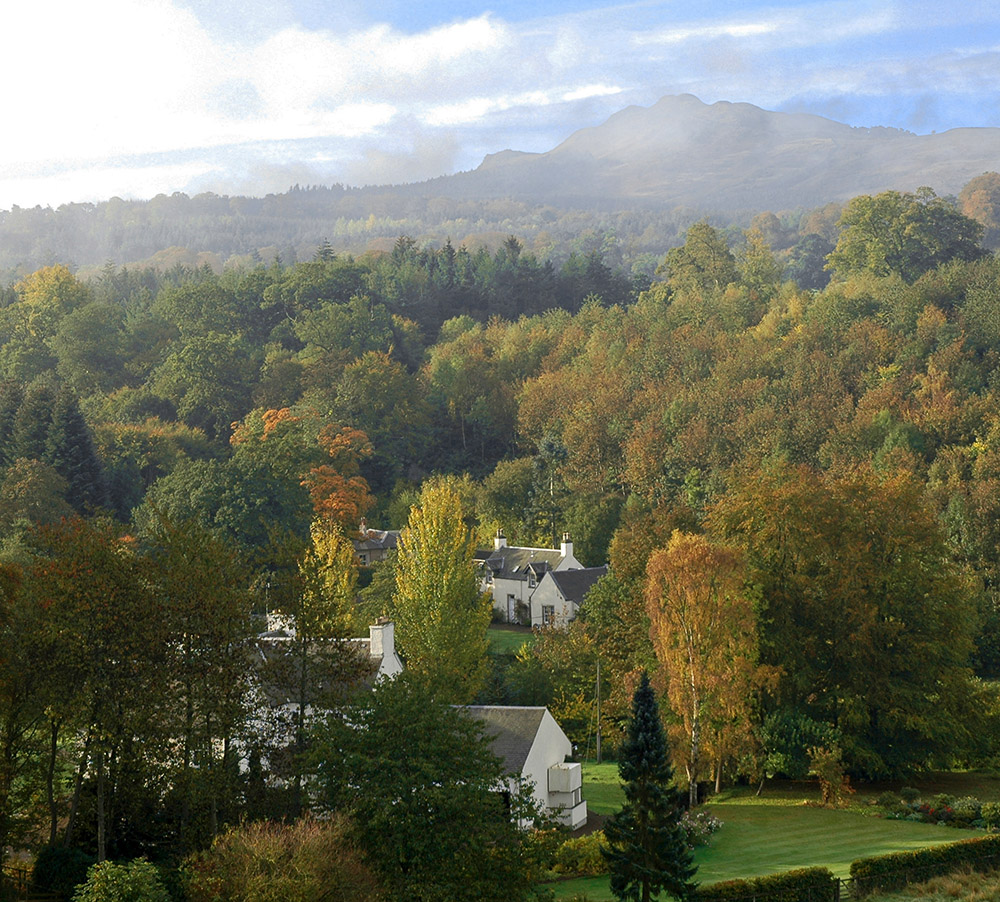Bedrule, birthplace of William Turnbull, (Bishop of Glasgow from 1448 to 1454)
By CATRIONA FINDLAY

"From the pavements, from the windows of houses, and from trams, buses and motor cars, whose, occupants for once cheerfully, acquiesced in a traffic hold-up. Glasgow folk watched a long chain of fire pass on Saturday night from the Cathedral to the heights of Gilmore hill." Thus the writer in the Glasgow Herald of January 8, 1951. described; a seen that had its beginnings over 500 years earlier, in Roxburghshire. For in the tiny hamlet of Bedrule, between Hawick and Jedburgh, was born William Turnbull who became 25th Bishop of Glasgow from 1448 to 1454, and the man responsible for the founding of Glasgow University in 1451. So it was appropriate that when the University was, celebrating its 500th centenary, a thread of fire symbolising the torch of learning should have been carried by a relay of 12 runners over the 100 miles from the Borders to the city.
On the Friday morning, Mr Walter Elliot, MP - who until shortly before had been Rector of the University - had drawn a brand from a log fire that burned outside Bedrule parish church.
"We give you godspeed on the old road." he had called in farewell to the first runners, setting off over the bleak white wastes of the snow-covered Borders “and the waygoing of Hawick, William Turnbull’s old town ‘Safe oot; safe in’”
Earlier in his speech he remarked that Borders "were always the very cockpit of hazard in life and in death" - and so they must, have been to people living there in the days of William Turnbull's birth; and indeed until much later. For all the tales of the Borders are of a wild land where wild men ruled and blood and passion were the stuff of normal" everyday life.
Bedrule itself was in ancient times in the possession of the powerful Comyn family; but after Robert Bruce's successes in the early 14th century wars he gave these lands of his enemies to his faithful Sir James Douglas, in whose family they remained until around the end of the century. For the following 200 years or so it was the Turnbulls, that small but disproportionately troublesome bunch, who held sway, not only in the Rule valley but considerably farther afield.
Close to present-day Bedrule is a grassy knoll, on which are faint traces of an ancient peel, reputedly a one-time stronghold of the Turnbulls. Here, around the last years of the 15th century, was the scene of the humiliation of the clan. During this century the Turnbulls were strong enough to defy the power of both the Sheriff and the March Warden; but towards its close King James IV marched against them. As his force came by Rule Water it was met by 200 Turnbulls, halters around their necks and naked swords in their hands. James. it is said. made good use of some of the halters.
This of course, wasn't the end of the Turnbulls. In 1545 an English force entered the Rule valley, burned 12 peel towers, harried the Turnbulls of their cattle, "and carried off and destroyed nearly all their household gear." After which the Turnbulls apparently considered it prudent to change sides, at least for a time, for they made several forays against their fellow Scots on behalf of the English until, at the battle of Ancrum Moor, they flung off the banner of St. George and changed sides yet again.
Later in the century the Turnbulls took part in the Raid of the Redeswire (commemorated today by a stone on the east side of the road over Carter Bar), one of those involved Border skirmishes which was complicated even further by some of the participants pursuing their personal feuds rather than the main job in hand, which was a meeting for the redress of injuries between the Croziers of Liddisdale and the Fenwicks of Northumberland. Present at the ensuing fray was "Auld Badroule, wi a the Turnbulls at his back."
But whether 'Badroule' 'Bed de. Rule’ as the writer in the First Statistical Account avers the locals pronounce it or 'Betherule' as his successor in 1845 states, it's a quieter place today than in former centuries. And its manse is in a particularly quiet and pleasant setting.
In the early days of the Church of Scotland the provision and upkeep of the parish minister's residence - the manse - was the responsibility of the local heritors, so naturally the accommodation offered varied considerably from parish to parish; some of it, as might well be imagined, of a very poor standard indeed. Things had to improve, however, and by the later years of the 18th century, in a flurry of new building, the manses erected were often scaled down versions of the popular and attractive small laird's house of those days - the house, in fact, that is still to be seen all over the country; the plain rectangular two-storeyed block with symmetrical interior layout, the central front door opening directly into a small lobby from which rose the staircase.
The Rev. Charles Findlater, writing in 1802, described such a manse.....”of dimension of from 34 to 40 feet in length, by from 19 to 22 feet in breadth, within the walls; the door is generally in the middle in the front, whence you enter upon a very small lobby and the staircase; on one hand is the kitchen, with a small division, probably taken off it, for scullery and servant's bed; on the other hand, is generally the best room, occupying the breadth of the house for its length. When you ascend the stair to the second storey, the space above the kitchen may he equally divided, making two small sleeping apartments: and the space above the best room is unequally divided, affording a sort of drawing room, with a small sleeping closet. The garret space, under the roof, may be divided into a place for lumber on one hand, and the other end fitted up with a couple of beds, into what is called a barrack room."
This basically was the type of house put up for the minister of Bedrule in 1794. What brought about the building of the new manse, we do not know; but perhaps the minister had been complaining about his old accommodation being unsatisfactory. Certainly the entry in the First Statistical Account (usually written by the parish minister, but there is no such acknowledgement for this one) states that "the manse is also in a bad state; but as it has been twice condemned, once by a jury of tradesmen appointed by the presbytery according to the law, June 20, 1792; another time, by a second jury of tradesmen, by order of the Court of Session, mutually chosen by the heritors and presbytery 26 July 1793; it is to be rebuilt and in a situation more dry and less exposed than the present one, and also at a small distance from the church.
 And so, apparently, it was done; for the writer in the 1845 Statistical Account states that the manse was built "according to the date affixed to the lintel of the kitchen window, in 1794, and is a very substantial and commodious house, without any gaudy ornaments as some lately erected manses. The great objection to it is the too great number of windows, which lay a tax on the minister disproportioned to his stipend. Half the number of windows would have been sufficient: but it was built when clergymen paid no window tax”
And so, apparently, it was done; for the writer in the 1845 Statistical Account states that the manse was built "according to the date affixed to the lintel of the kitchen window, in 1794, and is a very substantial and commodious house, without any gaudy ornaments as some lately erected manses. The great objection to it is the too great number of windows, which lay a tax on the minister disproportioned to his stipend. Half the number of windows would have been sufficient: but it was built when clergymen paid no window tax”
A cry straight from the heart - or pocket - these last two sentences. Or so it would seem; for the entry was written by the Rev. Archibald Craig. presumably the then incumbent of Bedrule. and the man who had to pay the "disproportionate" amount of tax.
Bedrule Old Manse, as it is today, for it was sold by the Church of Scotland 11 years ago, as well as being the stipulated "small distance from the church" is in a very sunny and sheltered site, the garden and glebe bordered by the Rule Water which flows to join the Teviot some two miles farther north. Since 1970 it has been the home of Mr and Mrs W. Jeffrey and their family; but although it was from Hove in Sussex that Mr Jeffrey moved to Bedrule it was, in a way, something in the nature of a homecoming, for he was born in Jedburgh which is, after all, within walking distance of Bedrule.









